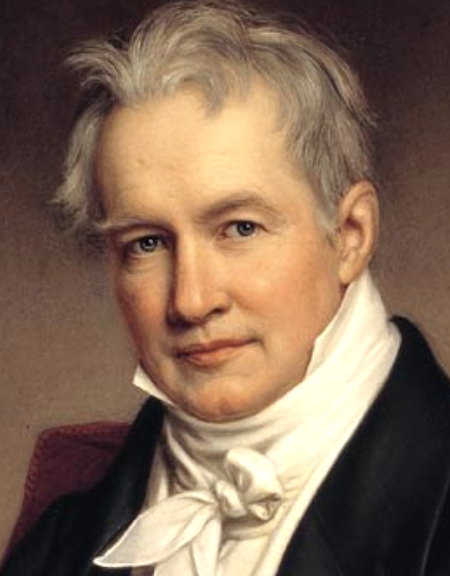On this date in 1769, Friedrich Wilhelm Heinrich Alexander von Humboldt, who came to be known as one of the greatest explorers of his time, was born in Berlin to a prominent Pomeranian family. Baptized Lutheran, he and his older brother, Karl Wilhelm, were educated by private tutors in the classics, French, mathematics, philosophy, politics and law. Botany quickly became Humboldt’s favorite subject and, even at an early age, he collected and classified insects and plants at his family’s estate in Tegel.
At age 16 he attended physics lectures at a physician’s home, learned of Benjamin Franklin and installed a lightning rod on Castle Tegel, which the local clergy deemed “blasphemous.” At 22 he completed his studies in geology, a new science at the time, and became a mine inspector who would later advocate for the welfare of miners. Humboldt was introduced to Goethe in 1794 and they became close friends and intellectual comrades. Goethe reportedly said that he could learn more in an hour of conversation with Humboldt than in a week of reading books.
Restless and curious about the world, Humboldt resigned from the mining business, traveled around Europe (developing revolutionary theories on the geological structure of Spain), and in 1799 embarked on an expedition of scientific discovery. He traveled for five years, visiting and exploring the Americas, where he was horrified by the practice of slavery. On this voyage, in addition to establishing the foundations of geography and meteorology, Humboldt met Thomas Jefferson and was deeply impressed by his enlightened political views but could not reconcile that he owned slaves.
He contracted malaria in South America and was nursed back to health by cannibals. He wrote with dismay about their treatment by the Jesuits and remarked at their deep sense of humanity. Upon his return to Europe, Humboldt published writings of his travels and scientific discoveries, which brought him fame throughout Europe. He became an active voice in politics, supporting the 1848 revolutions, universal political rights, the emancipation of the Jews and championing the rights of impoverished artists and scientists who faced persecution.
In 1845, at 77, Humboldt wrote Kosmos: Entwurf einer physischen Weltbeschreibung (Draft of a Physical Description of the World), hailed as one of the century’s most extraordinary scientific works. Kosmos attempted to explain the unity of the universe with naturalistic (rather than spiritual) laws, easily understandable to the public. It was never finished but it was an encyclopedic treasure of all that was known of the physical sciences in the mid-nineteenth century.
Among his other achievements: He was the first to raise anthropologists’ awareness of the neglected Incan, Mayan and Aztec civilizations; the first in astronomy to observe a meteor shower with scientific instruments; he collected over 60,000 plants and identified 3,500 new species; his maps of Central and South America were the first for geographers; he was the first to accurately understand volcanic activity.
Humboldt died at age 89 in the same year Darwin‘s On the Origin of Species was published. A state funeral was held for him with over 600 people, including many students, attending. He was buried in Tegel next to his brother. (D. 1859)


